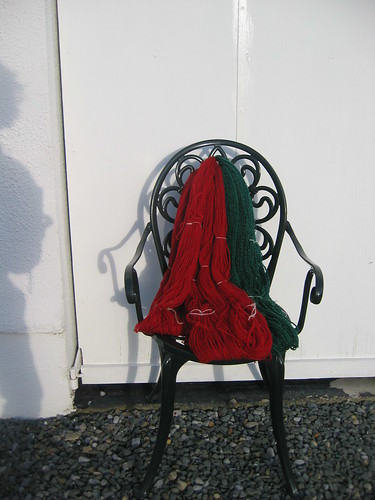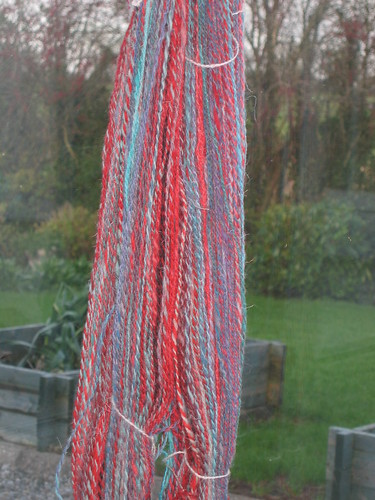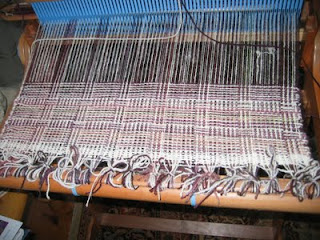Monday, December 5, 2011
Training Setanta Link
The young ram, Setanta, has is own link - www.trainingSetanta.blogspot.com/ included in my Woolie Links list here. But should an Easycare X Wiltshire Horn sheep be placed under Woolie Links seeing as how he sheds his fleece every spring ?? Ah well, he crosses with the woolies to produce a lamb with a nice fleece so he can stay.
Sunday, November 27, 2011
Christmas Yarn
I loved dying and spinning this fleece into Christmas colored yarn. It's about 9wpi/worsted weight, around 100 yards+ per hank, 4 red, 3 green .


But now what can I make with it???
This was some more UK breed roving I dyed several colors. I just can't remember the sheep's breed right now - it will come to me. Iy might be Swaledale which the book "in Sheep's Clothing" describes as being generally rather coarse with kemp (check) but sometimes has a softer undercoat. I think this must have lot of undercoat - or perhaps be a first shear as it has a lot of soft stuff in it.
Anyway, it's a bit "kempy" and I have to pick these bits out but otherwise it it quite squishy and I think it will be a hat - perhaps a lined one. I need a new warmer hat anyway.
Friday, November 11, 2011
The mobius that's not mobius
The "Weaving in the SAORI way" group had a thread featuring a woven mobius.
This appeals to me because - well, a finished garment comes right off the loom (except for weaving straggely bits in, finishing etc) and because the SAORI philosophy about weaving is such a fee one - no major worries about producing something that looks like it was comercially produced - quite the opposite - the freer the the better.
So, eyeing my big stash of handspun yarns in all sorts of colors and weights, I decided to recruit some of them for a mobius.
Except it's not really a mobius - as I , like some others on the list, didn't want to add in the twist that gives the infinity symbol it's shape, rather, make one big loop that wraps around oth shoulders and neck.
I decided to make the warp 120" long to get a finished size around 100" - and 12" wid, aiming for a cloth of 10 - 11" wide. The biggest component of the yarns I choose had about 14 - 15 wraps per inch so I planned to use the 7.5 dent heddle. The narrower yarns could be doubled or trebbled.
The warp yarns are mainily lilac or yellow and lesser amount of grey or black. They are all wool - mostly from my mixed breed sheep with some other UK/EU breeds in small quantity (black Wensleydal and grey Gortland). The dark ones are silkier and very strong, the colored ones are springy. The springiness meant that I knew my hands would be in there separating the warps after each change of shed and that beating with the heddle was out as it would shear the fibers too much. Beating was done with the side of the hand after laying in the pick and with the stick shuttle on the nest shed. I got into this rhythm fairly easily and it was not a problem. In the event, just 2 warps came apart - each time it was a wooly single and I just tied on another warp so it wasn't a big deal. The big deal was waiting for the end!
The weft was laid in at 6 ends per inch - less dense than the warp to make a less dense or less rigid cloth.
I felt quite bold using red yarn where there was yellow and lilac yarn but it didn't look as loud as I feared as the colors of the hand dyed yarn tend to be muted anyway.
The idea with this (or so I gather anyway) is to weave a length of fabric as you would weave a scarf or table runner but leave it less than the desired finished length by an amount equal to the width of the fabric so that, in the end, the fringe from the beginning of the cloth (origionally tied to the front beam) could be freed and woven into the fringe at the end of the fabric - so completing a circular shape (or mobius if you twist the cloth oncce before doing the final cross weave). I weanted 100 inches so I planned to weave about 68" then untie the front fringe and stretch out the fabric, laying it over the front beam, pin the cloth to itself around the front beam and weave the free damgling front fringe through the still tied on back fringe.
I couldn't wait fo rthis end part as it somehow fascinated me. I'd done the maths (being aware that things would not be exactly as calculated owing to draw-in and a host of other imponderables), I'd measured out a 68" lenght of yarn to travel with the fabric and give me an idea how much I'd woven.
All went swimmimgly with bouts of weaving when I got the chance, then I got to the end and - darn! I hadn't left enough beginning fringe to stretch across the fabric and have a fringe too! I went and removed the cloth (bad idea) to think about it but decided well, I want to do that cross weave!! So I unwove a section at the beginning to make the beginning fringe long enough.. But now I needed to replace the end fringe - attach it to the back beam after rethreading each warp through a slot or hole! Grrr - no! so I tied it in bundels to the back beam then stretched it back to the front beam and pinned it around it and - gulp! - threaded a darning needle and over-undered my way across for each of the 150 ends.
Actually, you can get used to that too and it did work out. I tied overhand knots after weaving in 5 picks and had 15 nice knots then I detached it and did the same with the end fringe.
I quite like the look of this wrap on me. If it gets cold ennough, it may replace the knitted sawl I've been slinging around my neck recently.
This appeals to me because - well, a finished garment comes right off the loom (except for weaving straggely bits in, finishing etc) and because the SAORI philosophy about weaving is such a fee one - no major worries about producing something that looks like it was comercially produced - quite the opposite - the freer the the better.
So, eyeing my big stash of handspun yarns in all sorts of colors and weights, I decided to recruit some of them for a mobius.
Except it's not really a mobius - as I , like some others on the list, didn't want to add in the twist that gives the infinity symbol it's shape, rather, make one big loop that wraps around oth shoulders and neck.
I decided to make the warp 120" long to get a finished size around 100" - and 12" wid, aiming for a cloth of 10 - 11" wide. The biggest component of the yarns I choose had about 14 - 15 wraps per inch so I planned to use the 7.5 dent heddle. The narrower yarns could be doubled or trebbled.
The warp yarns are mainily lilac or yellow and lesser amount of grey or black. They are all wool - mostly from my mixed breed sheep with some other UK/EU breeds in small quantity (black Wensleydal and grey Gortland). The dark ones are silkier and very strong, the colored ones are springy. The springiness meant that I knew my hands would be in there separating the warps after each change of shed and that beating with the heddle was out as it would shear the fibers too much. Beating was done with the side of the hand after laying in the pick and with the stick shuttle on the nest shed. I got into this rhythm fairly easily and it was not a problem. In the event, just 2 warps came apart - each time it was a wooly single and I just tied on another warp so it wasn't a big deal. The big deal was waiting for the end!
The weft was laid in at 6 ends per inch - less dense than the warp to make a less dense or less rigid cloth.
I felt quite bold using red yarn where there was yellow and lilac yarn but it didn't look as loud as I feared as the colors of the hand dyed yarn tend to be muted anyway.
The idea with this (or so I gather anyway) is to weave a length of fabric as you would weave a scarf or table runner but leave it less than the desired finished length by an amount equal to the width of the fabric so that, in the end, the fringe from the beginning of the cloth (origionally tied to the front beam) could be freed and woven into the fringe at the end of the fabric - so completing a circular shape (or mobius if you twist the cloth oncce before doing the final cross weave). I weanted 100 inches so I planned to weave about 68" then untie the front fringe and stretch out the fabric, laying it over the front beam, pin the cloth to itself around the front beam and weave the free damgling front fringe through the still tied on back fringe.
I couldn't wait fo rthis end part as it somehow fascinated me. I'd done the maths (being aware that things would not be exactly as calculated owing to draw-in and a host of other imponderables), I'd measured out a 68" lenght of yarn to travel with the fabric and give me an idea how much I'd woven.
All went swimmimgly with bouts of weaving when I got the chance, then I got to the end and - darn! I hadn't left enough beginning fringe to stretch across the fabric and have a fringe too! I went and removed the cloth (bad idea) to think about it but decided well, I want to do that cross weave!! So I unwove a section at the beginning to make the beginning fringe long enough.. But now I needed to replace the end fringe - attach it to the back beam after rethreading each warp through a slot or hole! Grrr - no! so I tied it in bundels to the back beam then stretched it back to the front beam and pinned it around it and - gulp! - threaded a darning needle and over-undered my way across for each of the 150 ends.
Actually, you can get used to that too and it did work out. I tied overhand knots after weaving in 5 picks and had 15 nice knots then I detached it and did the same with the end fringe.
I quite like the look of this wrap on me. If it gets cold ennough, it may replace the knitted sawl I've been slinging around my neck recently.
 |
| All folded up |
 |
| Doubled |
 |
| No, that's not me - I'm not a weird white plaster boy-head from an auction room in the 1970's |
Needs a bit of tlc- next week.
********************************************
Sunday, October 16, 2011
Boneyard Shawl
Stephen West has a nice shawl pattern he called "Boneyard" - well best if he explains that name.
I thought I might use it after trying my hand at graduated dying i.e. not fading away from this mortal coil, just dying warn with increasingly more saturated color.
I have a little cuttie hogget who is half Iolo Owens-type Easycare ram (I call them Anglesey easies) and half woolie cross ewe. Her first shearing this year yielded a nice soft little fleece. Yes ther was some coarser hair=like stuff but I was able to flick this off easily while I spun it. I used that for the graduated blue/green/grey food dye experiment and quite like the relult:
So this seemed a good one to try Stephen's Boneyard:
I like this one and it feels lovely.
********
I thought I might use it after trying my hand at graduated dying i.e. not fading away from this mortal coil, just dying warn with increasingly more saturated color.
I have a little cuttie hogget who is half Iolo Owens-type Easycare ram (I call them Anglesey easies) and half woolie cross ewe. Her first shearing this year yielded a nice soft little fleece. Yes ther was some coarser hair=like stuff but I was able to flick this off easily while I spun it. I used that for the graduated blue/green/grey food dye experiment and quite like the relult:
So this seemed a good one to try Stephen's Boneyard:
I like this one and it feels lovely.
********
Sunday, September 25, 2011
A great link - Wild Fibers
That Bradford Count - Grrr can be so confusing. Much easier to just think of the fiber size in microns - even if I can't really think of a micron!.
The Wild Fibers web site has great information about - fibers of course :
http://www.wildfibres.co.uk/html/fibre_size.html#Micron-Bradford
Thank you, thank you Wild Fibers for rationalising some of the many variable that can get to you when I set about planning some spinning.
*************************
The Wild Fibers web site has great information about - fibers of course :
http://www.wildfibres.co.uk/html/fibre_size.html#Micron-Bradford
Thank you, thank you Wild Fibers for rationalising some of the many variable that can get to you when I set about planning some spinning.
*************************
Castletown G and multicolor yarn and fractal spoinning - in theory
As I went to Castletown Geoghan yesterday with Rosknit to do spinning in the Eco tent at the Green Village ( http://www.greenvillage.ie/ ), I think I'll call the resulting yarn "Castletown. Anyway, the bright multicolors of the roving I dyed remind me of little flags or bunting associated with castle fetes.
I dyed 134 grams (4.8oz) of BFL roving (Wingham Wool Works : http://www.winghamwoolwork.co.uk/ ) with KoolAid colors as folows:
The roving was soaked overnight in tepid water in the sink where the plug with its loose fit, leaked the water away slowly so the roving was just damp next morning. I divided it - unequally as it happens, 55 grams into one roasting tin and 77 grams into the other.
The top quarter or so get 2 packets of Tropical punch sprinkled, next quarter 1 1/2 packets of Orange, next quarter 2 packets of Lemonade and the last got one pack each of Lemon/Lime and Berry Blue.
I left that to soak in then pressed it with a spoon to get the dyes through to the back - but there were through anyway. I added s few drizzles of 1/4 Cider vinegar and water to leave a slight pool of water around the edges.
I placed the tins inside larger turkey roasting bags then they went into the fan over at 160 Degrees for 40 minuets. The water was clear then and I saw it boil a bit (Perhaps less heat next time?).
I let it cool in the oven, then out of the oven then took the bags off and cool to hand-hot. I poured on warm water at about the same temperature and then drained it off (still in the tins). I laid them on towels and rolled dthem up to let the liquid gently soak out of the roving.
I opened the damp roving out flat so it wouldn't dry into a semi-felt and so ti would dry more quickly, then I hung it in the hot press. Next day it was dry.
I stripped the larger part into two and spun that at 12:1 over 1/2 inch (around 24 tpi) on my Ashford Traveller , making singles of 20 wpi. BFL roving doesn't have the spring/bounce that my own sheep fleece has, spun as locks, hand carded or combed, so I find it needs quite a lot of twist to liven it up as the fibers tend to relax to flat. Plus, it does not become too hard even when spun quite tightly.
I finished spinning the longer-color-run single single while wearing two of my knitted shawls as the wind made a B-line for us spinners inside our partial tent. I discovered that drop spindles don't perform very well in the wind (duh..) and that Reggae music suits spinning on a wheel quite well, for short worsted-style anyway.
I was not supposed to spin the second part that evening - but couldn't resist so I divided the second part in two long wise again then each of these halves into three - trying to avoid too much color pooling and to mute the loud colors. This was a sort-of fractal spinning 'though my stuff is not accurate enough to ensure any sort of dependable pattern. I am hoping for some degree of repetitions of fairly solid bits followed by marled bits.
If it were accurate, and the four colors were ABC and D, then I'd expect that each individual color of the long-color-run singles repeats , when plied with the short-color-run singles would have one solid color bit and three marled bits:
Version:1.0 StartHTML:0000000155 EndHTML:0000001736 StartFragment:0000000475 EndFragment:0000001719
In my case, A=red, B=orange, C=Lemonade and D=blue-green. So in the first encounter with red on the long-color-run single, the plied short-color-run lined up with it would produce a strip with 1/4 solid red, 1/4/ red-orange, 1/4 red-yellow and 1/4 red-bluie/green.
Yeah, right! :).
Well see when the yarn is finished. I do think I'll not get too much pooling - but will get lots of marled parts.
Long-Color-Run single
Short-color-Run single
Don't treadle with a shoe that has a strap over your instep - no matter how cold it is nor how loose the strap! I did that yesterday and after my compulsion to get all the spinning done (well it was only 4.8 oz) I hobbled away from the wheel as my right ankle was bandjaked! That's an ankle with a somewhat raised instep acquired while doing ballet as a child and not usually a problem but the strap on my shoe must have been aggravating the heck out of it during treadling. While it's way better today, the finished yarn will have to wait a while to be plied:
I wondered where the "inspiration" for this color way came from then I looked out the window straight in front of me:
Sure the yarn doesn't look quite so green in the photos (it is actually a bit more lime green in places and the blue not so obvious as those blowers, but I'd say it directed my selection all the same. Nothing to do with castles or bunting just da front garden.
******************************************************************************************
I dyed 134 grams (4.8oz) of BFL roving (Wingham Wool Works : http://www.winghamwoolwork.co.uk/ ) with KoolAid colors as folows:
The roving was soaked overnight in tepid water in the sink where the plug with its loose fit, leaked the water away slowly so the roving was just damp next morning. I divided it - unequally as it happens, 55 grams into one roasting tin and 77 grams into the other.
The top quarter or so get 2 packets of Tropical punch sprinkled, next quarter 1 1/2 packets of Orange, next quarter 2 packets of Lemonade and the last got one pack each of Lemon/Lime and Berry Blue.
I left that to soak in then pressed it with a spoon to get the dyes through to the back - but there were through anyway. I added s few drizzles of 1/4 Cider vinegar and water to leave a slight pool of water around the edges.
I placed the tins inside larger turkey roasting bags then they went into the fan over at 160 Degrees for 40 minuets. The water was clear then and I saw it boil a bit (Perhaps less heat next time?).
I let it cool in the oven, then out of the oven then took the bags off and cool to hand-hot. I poured on warm water at about the same temperature and then drained it off (still in the tins). I laid them on towels and rolled dthem up to let the liquid gently soak out of the roving.
I opened the damp roving out flat so it wouldn't dry into a semi-felt and so ti would dry more quickly, then I hung it in the hot press. Next day it was dry.
I stripped the larger part into two and spun that at 12:1 over 1/2 inch (around 24 tpi) on my Ashford Traveller , making singles of 20 wpi. BFL roving doesn't have the spring/bounce that my own sheep fleece has, spun as locks, hand carded or combed, so I find it needs quite a lot of twist to liven it up as the fibers tend to relax to flat. Plus, it does not become too hard even when spun quite tightly.
I finished spinning the longer-color-run single single while wearing two of my knitted shawls as the wind made a B-line for us spinners inside our partial tent. I discovered that drop spindles don't perform very well in the wind (duh..) and that Reggae music suits spinning on a wheel quite well, for short worsted-style anyway.
I was not supposed to spin the second part that evening - but couldn't resist so I divided the second part in two long wise again then each of these halves into three - trying to avoid too much color pooling and to mute the loud colors. This was a sort-of fractal spinning 'though my stuff is not accurate enough to ensure any sort of dependable pattern. I am hoping for some degree of repetitions of fairly solid bits followed by marled bits.
If it were accurate, and the four colors were ABC and D, then I'd expect that each individual color of the long-color-run singles repeats , when plied with the short-color-run singles would have one solid color bit and three marled bits:
Version:1.0 StartHTML:0000000155 EndHTML:0000001736 StartFragment:0000000475 EndFragment:0000001719
| Fractal spinning: second lot of fiber split in 3 or 3:1 fractal | ||||
| Long color roving | A | B | C | D |
| Second roving split in 3 | abcd, abcd, abcd | abcd, abcd, abcd | abcd, abcd, abcd | abcd, abcd, abcd |
| Solid=A. Marled=m | Ammm,Ammm,Ammm, | mBmm,mBmm,mBmm | mmCm,mmCm,mmCm | mmmD,mmmD,mmmD |
In my case, A=red, B=orange, C=Lemonade and D=blue-green. So in the first encounter with red on the long-color-run single, the plied short-color-run lined up with it would produce a strip with 1/4 solid red, 1/4/ red-orange, 1/4 red-yellow and 1/4 red-bluie/green.
Yeah, right! :).
Well see when the yarn is finished. I do think I'll not get too much pooling - but will get lots of marled parts.
Long-Color-Run single
Short-color-Run single
Don't treadle with a shoe that has a strap over your instep - no matter how cold it is nor how loose the strap! I did that yesterday and after my compulsion to get all the spinning done (well it was only 4.8 oz) I hobbled away from the wheel as my right ankle was bandjaked! That's an ankle with a somewhat raised instep acquired while doing ballet as a child and not usually a problem but the strap on my shoe must have been aggravating the heck out of it during treadling. While it's way better today, the finished yarn will have to wait a while to be plied:
I wondered where the "inspiration" for this color way came from then I looked out the window straight in front of me:
Sure the yarn doesn't look quite so green in the photos (it is actually a bit more lime green in places and the blue not so obvious as those blowers, but I'd say it directed my selection all the same. Nothing to do with castles or bunting just da front garden.
******************************************************************************************
Monday, September 19, 2011
Graduated blue green dyed hand spun
6.6 ounces divided into 1.1 ounce hanks and dyed progressively with blue and green food dye with a vinegar mordant. 350 - 400 yards.
Drafting Lindy's Shetland
This is just a video of drafting. It surprised me how much it looked like I was doing nearly all the work with the forward hand while in reality the back hand was doing a lot more in the way of drafting back and straightening the fibers.
That would make it 2,127 yrds/Lb - or Fingering weight and around 16 wpi and actually it is :).
So it's not lace weight when plied, though, of course, the singles were.
It doesn't look terribly impressive but it feels lovely and I think it's the nicest fiber I've spun so far.
First Hank. 1.7 oz, 2-ply, 226 yards
So it's not lace weight when plied, though, of course, the singles were.
It doesn't look terribly impressive but it feels lovely and I think it's the nicest fiber I've spun so far.
Yrds/lb;weight;WPI
Somewhere on the net, (I'll track it down eventully) is posted this useful information (well, useful if your're toying with weaving patterns and using hand spun yarn anyway):
Yrds/LB Yarn weight WPI
2600+ Lace 18+
1900-2400 Fingering 16
1200-1800 Sport 14
900-1200 Worsted 12
600-800 Bulky 10
400-500 V. Bulky 8
I think I most often end up with 14 WPI hand spun (Sport) but it might knit better as Worsted. My own sheep's fleece tend to be bouncy and these yarns probably punch above their weight.
That would suggest I'd use the 7.5 dent heddle on my Ashford knitters loom for plain weave - and this is probably true.
Just trying to get a handle on some of the variables I'd met with over the past few years.
Aghhh - look at this dreary background now - where did my design go?
Yrds/LB Yarn weight WPI
2600+ Lace 18+
1900-2400 Fingering 16
1200-1800 Sport 14
900-1200 Worsted 12
600-800 Bulky 10
400-500 V. Bulky 8
I think I most often end up with 14 WPI hand spun (Sport) but it might knit better as Worsted. My own sheep's fleece tend to be bouncy and these yarns probably punch above their weight.
That would suggest I'd use the 7.5 dent heddle on my Ashford knitters loom for plain weave - and this is probably true.
Just trying to get a handle on some of the variables I'd met with over the past few years.
Aghhh - look at this dreary background now - where did my design go?
Trying to catch up after confusion...
Forgot password or user ID or something and got into a mess with logging into this google blog account so now I can't remember quite what I'd planned to put here over the tail end of this summer. So I'm going to make a set of little pages about stuff that comes to mind in no particular order.
Here's a reminder of how lovely the lillies were this year:

Nuala's Flower with Sweet Pea behind. Colors for a yarn?
Here's a reminder of how lovely the lillies were this year:

Nuala's Flower with Sweet Pea behind. Colors for a yarn?
Thursday, September 8, 2011
Tuesday, August 23, 2011
Lindy's Shetalnd Fleece
We had a great time Friday last with Joan, Jennifer, Richard, George and Lindy. We stuffed ourselves as usual. The boys loved making a felted Lions Head with the gorgeous felting materials Lindy brought along. She also brought along some Shetland Sheep's fleece which had been residing with her for 14 years. I think it was a first-shear as it is pretty uniform staple, soft and has delicate pointed tips. ('twould be an old sheep by now!). Anyway, we watched the beginning of Margaret Stove's video on spinning merino for lace where she washes the locks individually. I decided to give this fleece that royal treatment and it seems to be working well.
This lot was done in about 10 - 15 minutes. Should be able to do about 2 per minute if there is plenty of water on the boil. It dried on a mesh on the hot press shelf in about 6 hours. I've spun some already and had to add foam pipe lagging to the spindle to get the tension low enough but it seems doable as a fine 2 or 3 ply without getting too firm.
Paul off work for a few days so we visited Clonmacnoise one day and the Locks Distillery today.
To be continued when photos from phone arrive.
Oíche mhaith.
This lot was done in about 10 - 15 minutes. Should be able to do about 2 per minute if there is plenty of water on the boil. It dried on a mesh on the hot press shelf in about 6 hours. I've spun some already and had to add foam pipe lagging to the spindle to get the tension low enough but it seems doable as a fine 2 or 3 ply without getting too firm.
Paul off work for a few days so we visited Clonmacnoise one day and the Locks Distillery today.
To be continued when photos from phone arrive.
Oíche mhaith.
Friday, August 19, 2011
Jute rug commences
I may be mad since I want to use some jute string I got in Fairfield mill this summer.
I've slayed the 7.5 dent heddle for the full 20" and made the warps about 60" long, planning for a 50" long rug.
The idea is to use my hand-spun yarn for the weft - doubled in some places. I've chosen the seaweed/dundukedymuck stuff - which I've developed an unexpected appreciation for.
So far, I've skinned only one finger while I fiddle around sampling to see what might work - loops - NO, too unstable, probably will go for areas of plain weave with the jute weft showing among rows of Soumak weaving. This might be a reaction to the somewhat tedious weaving of the soft-spun Wensleydale runner which needed handling with Kid gloves but was extremely soft on the hands. This still needs some edging - probably a chain or two of crochet and something done with the fringe plus matching place mats are in progerss.
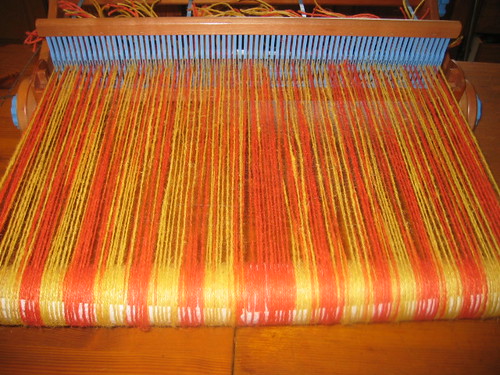
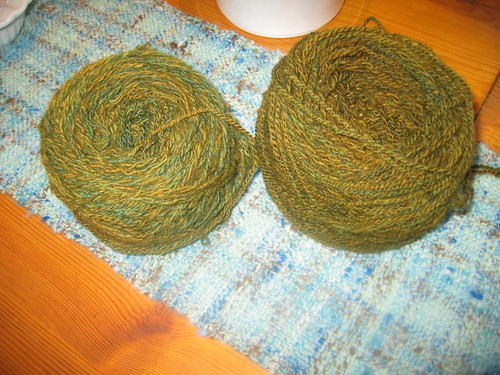


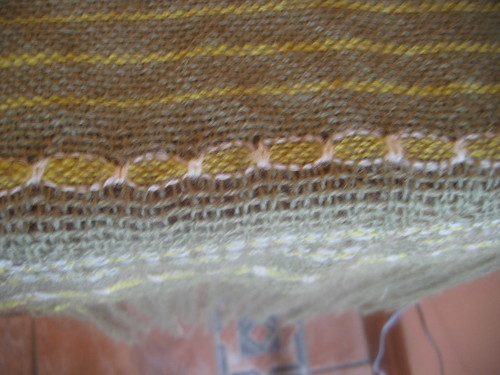
I've slayed the 7.5 dent heddle for the full 20" and made the warps about 60" long, planning for a 50" long rug.
The idea is to use my hand-spun yarn for the weft - doubled in some places. I've chosen the seaweed/dundukedymuck stuff - which I've developed an unexpected appreciation for.
So far, I've skinned only one finger while I fiddle around sampling to see what might work - loops - NO, too unstable, probably will go for areas of plain weave with the jute weft showing among rows of Soumak weaving. This might be a reaction to the somewhat tedious weaving of the soft-spun Wensleydale runner which needed handling with Kid gloves but was extremely soft on the hands. This still needs some edging - probably a chain or two of crochet and something done with the fringe plus matching place mats are in progerss.





Sunday, August 14, 2011
A little bit of lace
A small ball of unwashed lace weight yarn knit nicely into this bit of vine lace:
I love the vine pattern.
I love the vine pattern.
Monday, August 1, 2011
Dying Disasters
First, the bleeding chrysanthemum:
Bought 2 X 50 gm hanks of this BFL. Spun and chain-plied the first hank then - when I went to set the twist, it bled and bled .... Added vinegar to soak - bled and bled. Added washing up liquid - seemed to clear the orangie dye but next rinse, mauve bleed, now more orangie bleed....10 rinses later.....GRRRR.
Next - Seaweed and Dunduckedymuck:
Have two hanks of thick 2-plied hand spun in several shades of blue and a pink. The pink began to get on my nerves so I thought "Over-dye it with a yellow - change the blues to shades of greena dna the pink to brownis green - got the above 2 hanks. Very, earthy - very, very earthy.
Leaning, learning.
Bought 2 X 50 gm hanks of this BFL. Spun and chain-plied the first hank then - when I went to set the twist, it bled and bled .... Added vinegar to soak - bled and bled. Added washing up liquid - seemed to clear the orangie dye but next rinse, mauve bleed, now more orangie bleed....10 rinses later.....GRRRR.
Next - Seaweed and Dunduckedymuck:
Have two hanks of thick 2-plied hand spun in several shades of blue and a pink. The pink began to get on my nerves so I thought "Over-dye it with a yellow - change the blues to shades of greena dna the pink to brownis green - got the above 2 hanks. Very, earthy - very, very earthy.
Leaning, learning.
Thursday, July 28, 2011
Phillippa Joads Hand Painted Shetland
I spun this 200 gms of top at 12:1 over 1" , twist-assist then chain-plied at 5.5:1 over around 12" to keep the colors relatively unmixed. This hank is about 100 yards:
This hank will be added to the knitted scarf as per Jackie Erickson-Schweitzer's "Morning Surf" scarf - 'though this is more like "Evening on Heath":
Some was combined with my softer ECX first-shear DroimAnUan hand spun to knit a pair of wrist warmers as per Samantha Thompson's Urban Weave wrist warmers.
I used the rest, again combined with the white hand spin, to make a 20"ish X 20" Log Cabin weave which will form the decorative front for a cushion:
Got a lot of fun out of this.
This hank will be added to the knitted scarf as per Jackie Erickson-Schweitzer's "Morning Surf" scarf - 'though this is more like "Evening on Heath":
Some was combined with my softer ECX first-shear DroimAnUan hand spun to knit a pair of wrist warmers as per Samantha Thompson's Urban Weave wrist warmers.
I used the rest, again combined with the white hand spin, to make a 20"ish X 20" Log Cabin weave which will form the decorative front for a cushion:
Got a lot of fun out of this.
Nest
Seems this bird likes a bit of hand spun yarn along with the fleece, twigs and moss!
******************************************************************
******************************************************************
Subscribe to:
Posts (Atom)
